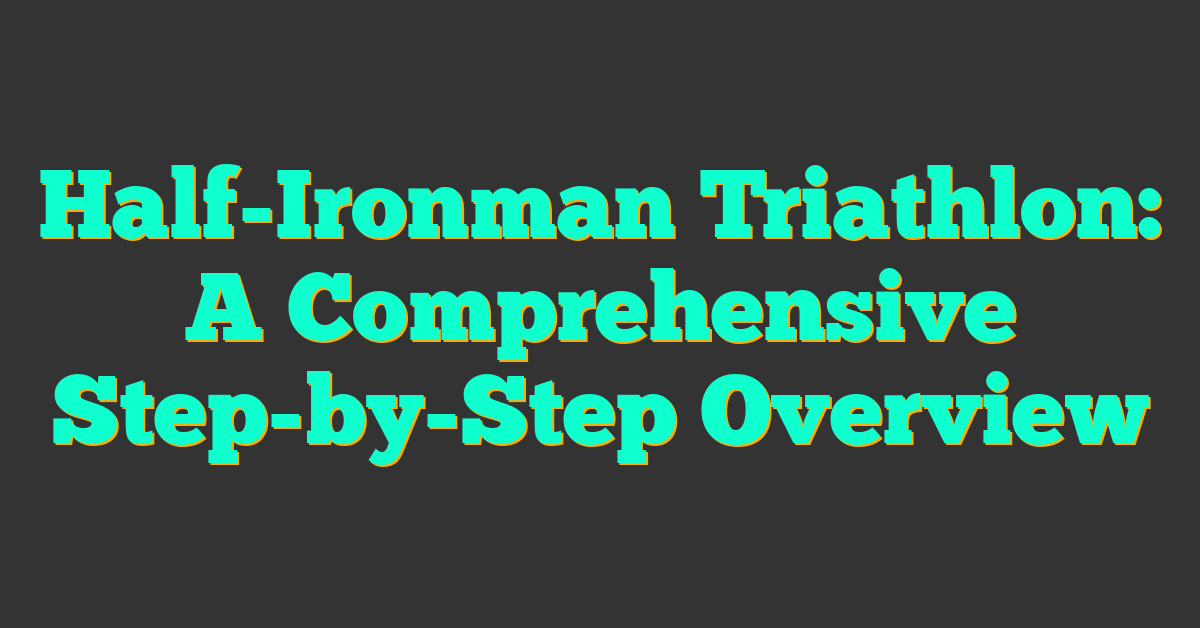Training for a Half-Ironman Triathlon might feel overwhelming at first, but taking it one step at a time makes all the difference. I’ve tackled this challenge myself, and I know how rewarding it can be when you break it down into manageable parts.

In this step-by-step overview, I’ll guide you through each phase of preparation, from building your endurance in swimming, biking, and running to mastering nutrition and mental strategies. Whether you’re aiming to set a personal record or just want to complete the race, this friendly guide will help you stay on track and enjoy the journey.
Understanding the Half-Ironman Triathlon
A Half-Ironman Triathlon, also known as Ironman 70.3, combines swimming, biking, and running over a total distance of 70.3 miles. The specific distances for each discipline are as follows:
| Discipline | Distance |
|---|---|
| Swim | 1.2 miles |
| Bike | 56 miles |
| Run | 13.1 miles |
Competing requires endurance, strategic training, and mental resilience. Knowing each segment’s demands helps me tailor my preparation effectively.
Training for Success
Achieving a Half-Ironman demands a well-rounded training regimen. I organized my training to enhance endurance, strength, and mental fortitude.
Swimming Preparation
- Technique: I incorporated drills three times a week, refining my stroke efficiency. Enhancing technique minimized energy loss during swims.
- Endurance: Progressively increased swim distance from 800 meters to 2 kilometers. Building endurance enabled consistent pacing throughout the race.
- Open Water Practice: Scheduled bi-weekly open water sessions to adapt to varying conditions. Familiarity with open water improved my confidence and navigation skills.
Cycling Strategies
- Distance Training: Included long rides reaching up to 50 miles each weekend. Extending cycling distances built the stamina necessary for race day.
- Interval Workouts: Implemented high-intensity intervals twice a week, boosting speed and cardiovascular capacity. Increasing cycling speed reduced overall race time.
- Bike Maintenance: Maintained my bike with regular checks and timely repairs. Ensuring optimal bike performance prevented mechanical issues during training and the event.
Running Techniques
- Consistent Mileage: Maintained a running schedule of four times a week, alternating between long runs and recovery jogs. Consistent mileage developed running endurance and resilience.
- Speed Training: Added tempo runs and sprints to improve pace and efficiency. Enhancing running speed contributed to better overall race performance.
- Strength and Flexibility: Engaged in strength training and stretching routines regularly. Building muscle strength and flexibility reduced the risk of injuries and improved running form.
Nutrition and Hydration Strategies
Effective nutrition and hydration strategies enhance performance and endurance during the Half-Ironman. I implement the following approaches:
Pre-Race Nutrition
Consuming a carbohydrate-rich meal 3-4 hours before the race builds energy reserves. Options include:
- Oatmeal with berries and honey
- Whole-grain toast with almond butter
- Banana and a sports drink
During the Race
Maintaining energy levels and electrolyte balance is essential. I use:
- Carbohydrates: Energy gels every 45 minutes
- Electrolytes: Sports drinks at aid stations
- Hydration: Drinking 500-700 ml per hour
| Strategy | Details |
|---|---|
| Carbohydrates | Energy gels every 45 minutes |
| Electrolytes | Sports drinks at aid stations |
| Hydration | 500-700 ml per hour |
Post-Race Recovery
- Proteins: Protein shakes or grilled chicken
- Carbohydrates: Fruits, energy bars, or quinoa
- Hydration: Water and electrolyte beverages
Essential Equipment and Gear
Swim Gear
- Wetsuit: Select a flexible wetsuit appropriate for the water temperature.
- Goggles: Choose goggles with anti-fog and UV protection features.
- Swim Cap: Use a silicone or latex cap to reduce drag.
- Swimwear: Opt for a triathlon-specific suit for comfort and performance.
Bike Gear
- Bicycle: Invest in a road or triathlon bike tailored for endurance and speed.
- Helmet: Ensure the helmet meets safety standards and fits securely.
- Cycling Shoes: Use clipless shoes for efficient power transfer.
- Bike Pedals: Select pedals compatible with your cycling shoes.
- Water Bottles: Carry hydration bottles accessible during the ride.
Run Gear
- Running Shoes: Choose shoes that provide cushioning and support.
- Socks: Wear moisture-wicking socks to prevent blisters.
- Running Apparel: Select lightweight, breathable clothing suitable for running.
Transition Items
- Transition Bag: Organize all gear in a designated transition bag for easy access.
- Race Belt: Use a belt to hold your race number and small essentials.
- Extra Clothing: Pack a change of clothes for after the race.
Accessories
- GPS Watch: Track your distance, pace, and heart rate accurately.
- Hydration System: Utilize a hydration pack or bottles for consistent fluid intake.
- Nutrition: Bring energy gels and electrolyte supplements to maintain energy levels.
- Sunscreen: Apply waterproof sunscreen to protect against sun exposure.
Safety Equipment
- Bike Lights: Use front and rear lights if racing in low-light conditions.
- First Aid Kit: Carry basic first aid supplies for minor injuries.
- Identification: Keep an ID and emergency contact information accessible.
Maintenance Tools
- Multi-Tool: Have a multi-tool for quick adjustments on the bike.
- Pump: Bring a portable pump to manage tire pressure.
- Spare Tubes: Keep spare tubes and tire levers for unexpected flats.
By ensuring you have the essential equipment and gear, you can focus on your performance and enjoy the Half-Ironman experience.
Race Day Planning
Pre-Race Preparation
I start my race day by ensuring all my gear is packed the night before. I lay out my triathlon suit, goggles, bike, helmet, running shoes, and nutrition supplies. I also double-check my race packet for any last-minute updates. Arriving at the venue at least one hour early allows me ample time for setup and any unexpected issues.
Transition Setup
I set up my transition area efficiently. First, I place my bike in the designated spot, securing it with straps. Next, I organize my running shoes and helmet within easy reach. My nutrition items, like energy gels and hydration bottles, stay nearby to maintain quick access. Keeping transitions clutter-free reduces stress and saves valuable time during the race.
Warm-Up Routine
Warming up is crucial for optimal performance. I spend about 15 minutes doing dynamic stretches and light jogging. This routine increases my heart rate, loosens muscles, and mentally prepares me for the race ahead. A proper warm-up helps prevent injuries and enhances my overall race performance.
Nutrition and Hydration Strategy
I follow my nutrition plan meticulously. Three hours before the race, I consume a carbohydrate-rich meal, such as oatmeal with berries and a banana. During the swim and bike segments, I sip on my sports drink to stay hydrated. Every 45 minutes on the bike, I take an energy gel to maintain my energy levels. Proper hydration and nutrition keep me fueled throughout the race.
Pacing and Strategy
I stick to a pre-determined pacing plan to avoid burnout. During the swim, I focus on maintaining a steady pace without expending too much energy. On the bike, I use my GPS watch to monitor my speed and adjust accordingly. In the run, I maintain a consistent stride, ensuring I conserve enough energy for the final leg. Adhering to my pacing strategy helps me complete each segment efficiently.
Mental Preparation
Mental readiness complements physical preparation. I visualize the race course, anticipate challenges, and remind myself of my training achievements. Positive self-talk and focusing on each segment one at a time keep me motivated. Staying mentally strong helps me push through fatigue and stay focused on my goals.
Gear Management
I keep my gear organized and easily accessible. During transitions, I quickly switch from swim to bike, ensuring my bike is secure and my running shoes are ready. I use a transition bag to carry spare items like a race belt, sunscreen, and a small towel. Efficient gear management minimizes transition time and keeps me on track.
Final Checks
Before the race starts, I perform final checks on my equipment. I ensure my bike gears are properly adjusted, my helmet is secure, and my hydration system is filled. I also verify that I have all necessary nutrition and emergency contacts. These final checks prevent last-minute issues and ensure I’m fully prepared for race day.
Starting the Race
I position myself at the swim start, staying calm and focused. I take a few deep breaths, signal to the officials if needed, and begin the swim at a controlled pace. Starting strong with confidence sets a positive tone for the rest of the race. Maintaining focus during the start helps me transition smoothly into each subsequent segment.
Race Execution
Throughout the race, I adhere to my plan, adjusting as needed based on conditions. I monitor my hydration, nutrition, and pacing, making small adjustments to stay on course. Staying adaptable while following my strategy allows me to handle unexpected challenges and maintain steady progress toward the finish line.
Post-Race Routine
« Solo Training Tips for Triathlon Success: Boost Your Performance Solo
How to Train for Triathlon with a Pull Buoy: Boost Your Swim Performance »
After crossing the finish line, I prioritize recovery. I hydrate with an electrolyte drink and consume a protein-rich snack to aid muscle recovery. Gentle stretching helps alleviate muscle tension, and I take time to cool down mentally and physically. Post-race recovery ensures I bounce back quickly and prepare for future training.
Recovery and Injury Prevention
Effective recovery accelerates my progress and reduces injury risks. I prioritize post-race nutrition by consuming a balanced meal within 30 minutes, including 20 grams of protein and 40 grams of carbohydrates, such as a protein shake with a banana. Hydration follows, aiming for 1 liter of electrolyte-enhanced water within the first hour after finishing.
Rest plays a crucial role in my recovery. I ensure 7-9 hours of quality sleep each night to support muscle repair and overall healing. Incorporating active recovery, I engage in low-impact activities like walking or gentle cycling for 30 minutes on non-training days to maintain circulation and flexibility.
Stretching and foam rolling help prevent muscle stiffness and enhance mobility. I dedicate 15 minutes daily to stretching major muscle groups and use a foam roller to release tension in areas like my calves, thighs, and back.
Injury prevention starts with my training regimen. I follow the 10% rule, increasing my weekly training volume by no more than 10% to avoid overuse injuries. Strength training complements my endurance workouts, focusing on core stability and lower body strength with exercises like squats and planks twice a week.
Proper gear selection minimizes injury risks. I wear well-fitted running shoes, replace them every 300 miles, and ensure my bike is properly adjusted to prevent strain. Listening to my body allows me to recognize early signs of fatigue or discomfort, prompting me to rest or seek professional advice as needed.
Regular check-ins with a sports therapist aid in maintaining my physical health. They help address minor issues before they escalate, ensuring I stay on track with my training goals. By implementing these recovery and injury prevention strategies, I maintain peak performance and enjoy a sustainable triathlon journey.
Conclusion
Taking on a Half-Ironman was one of the most rewarding experiences of my life. Every training session brought me closer to my goal and taught me the value of persistence.
Seeing all the pieces come together on race day was unforgettable. The support from fellow athletes and the thrill of crossing the finish line made all the hard work worth it.
If you’re considering a Half-Ironman, trust the process and enjoy every step of your journey. You’ve got this!










